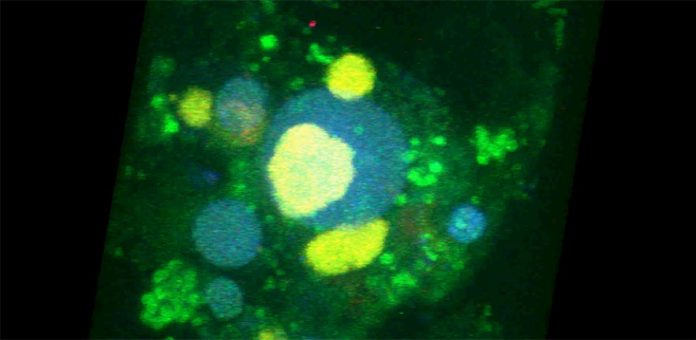Scientific and public appreciation for microbes — and the key role their communal actions play in environmental health, food production, and human wellness — has grown in recent years. While initially considered to be static, uniform entities, microbial communities are highly complex and contain internal chemical swapfests that are in constant flux.
Researchers at Illinois led by Associate Professor of Bioengineering Ting Lu (BCXT/BSD/CABBI/MME) have demonstrated that the dynamics of these communities can be explained and even predicted by examining the variability trait of microbial social interactions. Lu and his coauthors, including co-first authors Feng Liu and Junwen Mao and Grainger Distinguished Chair in Engineering Rashid Bashir (ONC-PM/RBTE), shared their work in Nature Communications.
“The ultimate goal of our research is to develop effective strategies to program the composition and functionality of microbial communities,” Lu said. This broader goal is shared by the Microbiome Metabolic Engineering research group at the Carl R. Woese Institute for Genomic Biology, of which Lu is a member. “But to achieve this kind of engineering capacity, there’re several key steps. The first step is to understand how microbial communities change over time, the second is to predict the dynamics, and the third is to engineer it.”
In the present study, Lu’s group aimed to begin a transition between the first and second steps, from the perspective of microbial interactions such as competition and cooperation, major biotic driving forces of community behaviors.
“There is increasing evidence that microbial interactions are dynamic over time, instead of invariant,” Lu said. “They often change with environmental cues, such as pH, nutrient and stress, and are also subjective to the population of microbes generating the interactions and the presence of other species.”
“But there are little experimental investigations that are trying to elucidate how such variations contributes to community structures,” Lu continued. “We hypothesize that this form of variation is an important determinate that regulates community dynamics and that characterizing it can empower the predictions of ecosystem succession from the bottom up.”
To test the hypotheses, Lu and his colleagues wanted to utilize communities in which bacteria cooperate or compete in easily observable and controllable ways. They turned to synthetic communities of Lactococcus lactis, the bacterium that helps ferment milk into cheese, due to their reduced complexity compared to native ecologies.
One important way that microbes interact is through the exchange of the compounds they produce — nutrients, chemical signals, and even toxins that kill off competitors. Lu’s team created two L. lactis strains, Cα and Cβ, each of which could produce one subunit of an antimicrobial peptide (small protein) called nisin.
“Each of the strains is able to produce an inactive subunit. However, when together, the two strains released subunits that self-assemble into active nisin,” Lu said. Experiments confirmed that, when teamed up, the engineered Cα and Cβ could indeed cooperate to fight against Ks, another strain which produces its own toxin.
The team examined the outcomes of communities formed by Cα, Cβ and Ks, and found that increasing the variations of Cα — Cβ cooperation, from either altered labor partition or random sampling, drives the community into distinct structures. They also studied ecosystem succession in different environmental pH using Cα, Cβ and another strain, Kp, that is resistant to bacteriocin at certain levels of acidity. Their study showed that, when the cooperation and competition are additionally modulated by pH, ecosystem succession becomes jointly controlled by the variations of both interactions and yields more diversified dynamics — some communities changed dramatically over time, while other stayed more stable.
The researchers constructed mathematical models that explicitly incorporated the variability of interaction into ecosystem description.
“Asking for seamless integration of experiment and modeling was the most challenging part [of the study]. But it was also the most exciting part, because the model — which incorporated the variability from the experimental measures — allowed us to correctly predict the behavior [of the microbial communities,]” Lu said.
The team hopes that this work would serve as a foundational step toward the analysis, prediction, and engineering of complex communities such as those that we rely on for many human endeavors and our own health. “This study used simple, synthetic consortia,” Lu said “We look forward to working on naturally occurring communities . . . hopefully by studying those native ecologies, we will be able to establish basic rules of community organization and even develop feasibility to engineer ecosystem functionality.”
First author Feng Liu is also affiliated with East China University of Science and Technology; first author Junwen Mao is also a physicist at Huzhou University. This work was supported by the National Science Foundation, the Office of Naval Research, and the Department of Energy.















